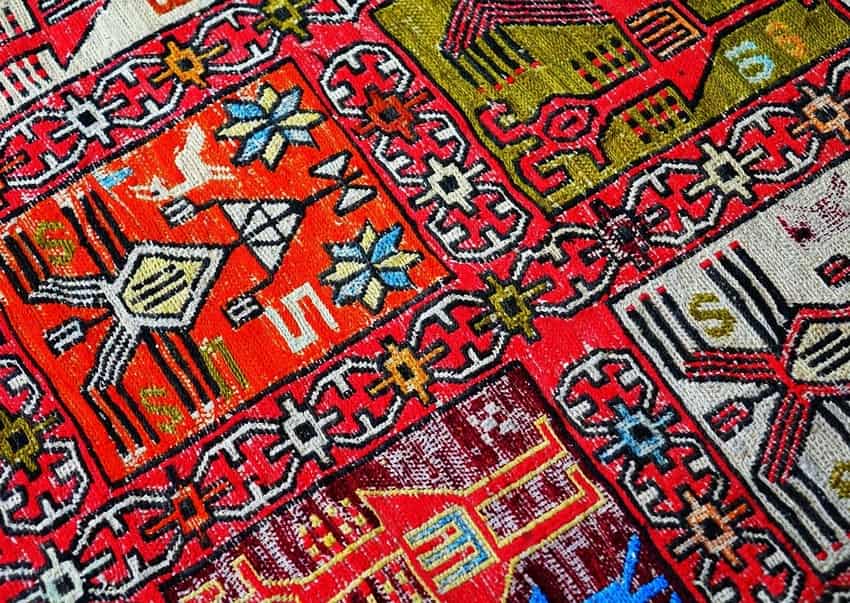
You bought a nice carpet you saw online. You liked the shape, the colors, and the description, but the picture was fuzzy. Did it look like it was hand-woven? And are you sure you saw knots interspersed throughout its design? Eh, does it even matter? You tell your in-laws you bought a "Persian Rug," but when you see your neighbor outside, you proudly announce you just got a great deal on an "Oriental Rug." You’re not sure of the difference between either, but should you invest in Persian rug cleaning?
"Oriental Rug" is a bigger category that includes any hand-knotted rug crafted in Asia. "Persian Rugs" are perched beneath the canopy known as oriental rugs, but thanks to their precise country of origin, their fame, and the inimitable knot employed in their production, they have earned recognition in their own category.
What's an Oriental Rug?
To clarify, a true oriental rug is any carpet hand-knotted in an Asian country (China, India, Iran, Pakistan, Russia, Tibet, and Turkey). Once China became a global exporter powerhouse, it soon morphed into a top supplier of oriental rugs. The country has a proud centuries-long cultural tradition of carpet-weaving, but it’s only in the last few decades that its rugs have been “discovered” by consumers in the western hemisphere. In any industry with sudden consumer demand, the manufacturing process must change to keep pace – which is exactly what happened in China. Now, these carpets have proliferated around the world, boosting the need for affordable oriental rug cleaning services.
If you’ve ever wondered why oriental rugs are expensive and rare, it’s because of the detail and craftsmanship involved. They’re all hand-woven using a loom, with yarn painstakingly knotted string-by-string throughout the weave to fashion ornate designs. Most of these rugs have a design pattern that uses the symmetrical Ghiordes or “Turkish Knot.” Other characteristics of these timeless rugs are the materials used – wool, silk, and bamboo – and how they’re decorated. Intricate designs and symbols reflect cultural heritage and countries-of-origin: Classic geometric shapes, animal and floral patterns, majestic landscapes, contrasting colors, and differing textures to mimic three-dimensional effects.
What’s a Persian Rug?
A Persian Rug is a type of carpet that is hand-knotted in modern-day Iran. Their popularity, unique features, and prevalence have earned them their own category beneath the oriental rug umbrella.
Highly traditional and artistic, hand weaving took root in Persia thousands of years ago, with the oldest surviving Persian carpet estimated to be more than 2,400 years old. Techniques are passed down through the generations, with some dating back centuries. Specific geography -- region, city, or tribal origin – give certain Persian rugs their name, with cities and regions famous due to their own centuries-long techniques or distinctive styles. This means each Persian rug, including yours, has a lot to say about itself based on their design patterns and how they’re made.
Two widespread designs are the central medallion and “all-over” patterns. All-over features a repeating geometric or floral pattern throughout the rug, while the central medallion pattern presents a circular or oval pattern in the middle, often taking a geometric shape. Besides these designs, Persian rugs are normally woven utilizing the Persian Knot, a special knotting technique that doesn't correspond to another arrangement, shape, or size.
The Best Rug Cleaning for Your Oriental or Persian Rug
Sunlight is the Enemy
Sunlight is the supervillain in your rug's fight for survival. Ultraviolet rays result in fading and will dry the oils within the fibers, making them brittle and susceptible to damage. If your rug gets regular exposure to the sun, monitor it carefully for early signs of damage. A rug without signs of damage beyond the piles can normally be saved from permanent harm with professional rug cleaning.
Protect Against Foot Traffic
If your rug is exposed to regular foot traffic, be sure to turn or flip it periodically. This will ensure the rug wears evenly and last for many years.
Be Gentle When You Vacuum or Sweep
Because dirty rugs wear out faster, they need to be vacuumed or swept frequently. If you vacuum, use suction-only or set your cleaner to “bare floor” mode so the roller brush doesn’t spin. You can also gently sweep the rug to remove debris and dust but avoid beating or shaking the rug to clean it.
Protect While Storing
In most cases, moths and other insects will avoid a rug that’s being used, but a rug in storage for months on end is a different story. This is when insects and moth larvae do the greatest damage. To protect your rug, clean it, roll it with mothballs, then double or triple bag the rug in garbage bags and seal it tightly. This has two benefits: killing any moth larvae and keeping more from getting into the rug.
Consult with a Professional Cleaner
Oriental and Persian rugs should be professionally cleaned periodically to extend their lifespan and keep colors bright. Persian rug cleaning professionals have the expertise needed to achieve this end but remember – deep cleaning your rug can result in loss of color, staining, and damaged rug fibers.
Think of Oriental and Persian rugs as financial investments, increasing in value as they age and, with proper care, lasting for decades as an heirloom to be passed down for generations. Steve’s Carpet Care has been in business for more than 40 years. We’ve built our business on outstanding products and customer service and take pride in fostering customer relationships based on mutual respect. Contact us today online or by calling 303-530-4900 for more information.
